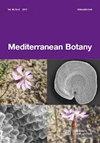Use of machine learning to establish limits in the classification of hyperaccumulator plants growing on serpentine, gypsum and dolomite soils
IF 0.7
4区 生物学
Q3 PLANT SCIENCES
引用次数: 4
Abstract
The so-called hyperaccumulator plants are capable of storing hundred or thousand times bigger quantities of heavy metals than normal plants, which makes hyperaccumulators very useful in fields such as phytoremediation and phytomining. Among these plants there are many serpentinophytes, i.e., plants that grow exclusively on ultramafic rocks which produce soils with a great proportion of heavy metals. Even though there are multiple classifications, the lack of consensus regarding which parameters to use to determine whether a plant is a hyperaccumulator, as well as the arbitrariness of stablished thresholds, bring about the need to propose more objective criteria. To this end, plant mineral composition data from different vegetal species were analysed using machine learning techniques. Three complementary case studies were established. Firstly, plants were classified in three types of soils: dolomite, gypsum and serpentine. Secondly, data about normal and hyperaccumulator plant Ni composition were analysed with machine learning to find differentiated subgroups. Lastly, association studies were carried out using data about mineral composition and soil type. Results in the classification task reach a success rate over 75%. Clustering of plants by Ni concentration in parts per million (ppm) resulted in four groups with cut-off points in 2.25, 100 (accumulators) and 3000 ppm (hyperaccumulators). Associations with a confidence level above 90% were found between high Ni levels and serpentine soils, as well as between high Ni and Zn levels and the same type of soil. Overall, this work demonstrates the potential of machine learning to analyse data about plant mineral composition. Finally, after consulting the red list of the IUCN and those of countries with high richness in hyperaccumulator species, it is evident that a greater effort should be made to establish the conservation status of this type of flora.利用机器学习对生长在蛇纹石、石膏和白云石土壤上的超积累植物进行分类
这种被称为“超蓄积体”的植物能够储存比普通植物多数百或数千倍的重金属,这使得“超蓄积体”在植物修复和植物挖掘等领域非常有用。在这些植物中,有许多蛇生植物,即只生长在超镁铁质岩石上的植物,这些岩石产生含有大量重金属的土壤。尽管存在多种分类,但对于使用哪些参数来确定植物是否为超蓄积物缺乏共识,以及既定阈值的任意性,导致需要提出更客观的标准。为此,使用机器学习技术分析了来自不同植物物种的植物矿物成分数据。建立了三个互补的案例研究。首先,将植物分为白云岩、石膏和蛇纹石三种土壤类型。其次,利用机器学习分析正常植物和超富集植物镍成分数据,找到不同的亚群。最后,利用矿物组成和土壤类型数据进行关联研究。结果分类任务成功率达到75%以上。以百万分之一(ppm)为单位的镍浓度对植物进行聚类,结果有四组,截止点分别为2.25、100(蓄积体)和3000 ppm(超蓄积体)。高镍含量与蛇纹石土壤之间,以及高镍和高锌含量与同一类型土壤之间,相关性的置信度均在90%以上。总的来说,这项工作证明了机器学习在分析植物矿物成分数据方面的潜力。最后,在参考了世界自然保护联盟的红色名录和超积累物种丰富度高的国家的红色名录后,显然应该作出更大的努力来建立这类植物群的保护地位。
本文章由计算机程序翻译,如有差异,请以英文原文为准。
求助全文
约1分钟内获得全文
求助全文
来源期刊

Mediterranean Botany
Agricultural and Biological Sciences-Plant Science
CiteScore
2.40
自引率
10.00%
发文量
30
审稿时长
12 weeks
期刊介绍:
Mediterranean Botany (ISSNe 2603-9109), formerly Lazaroa, is a biannual journal that publishes original research studies in the field of Botany including plant systematics, vegetation ecology, biogeography, evolutionary biology, ecophysiology, community ecology, ethnobotany and conservation biology on Mediterranean biomes but also in interacting areas.
Mediterranean Botany is an OPEN ACCESS Journal, free of charges for any published article.
 求助内容:
求助内容: 应助结果提醒方式:
应助结果提醒方式:


